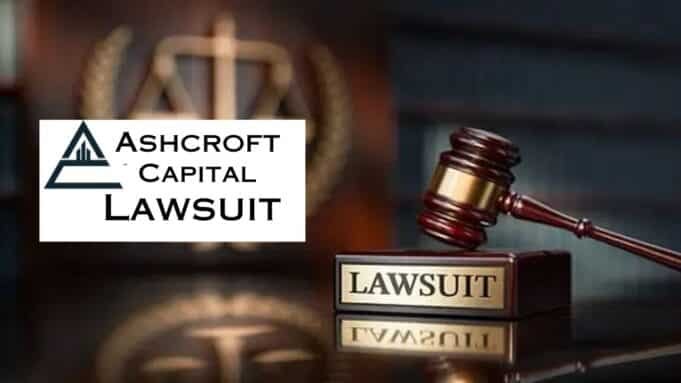Ashcroft Capital, co-founded by Joe Fairless and Frank Roessler, is a U.S.-based real estate syndication firm recognized for specializing in value-add multifamily investments. Over the years, the company has gained attention for scaling its operations and attracting accredited investors seeking passive real estate opportunities.
In early 2025, the Ashcroft Capital lawsuit emerged as a high-profile case, raising concerns around trust, transparency, and investor protection in the real estate syndication space. The case has quickly evolved into a touchpoint for debates about sponsor accountability, proper disclosure, and fiduciary duties within the industry.
Background on Ashcroft Capital
Ashcroft Capital has built a reputation as one of the prominent players in real estate syndications, operating on a value-add investment model where properties are acquired, improved, and repositioned for higher returns. Its portfolio has spanned across U.S. growth markets, attracting thousands of investors into multifamily projects.
The company has consistently marketed itself as delivering strong risk-adjusted returns through disciplined acquisitions and operational improvements. This positioning has helped build credibility, though it also heightened investor expectations—making the lawsuit even more significant in evaluating how syndication promises align with outcomes.
Read More: Travel Resorts of America Lawsuit
Ashcroft Capital Lawsuit Overview
On February 12, 2025, a lawsuit titled Cautero v. Ashcroft Legacy Funds, LLC, et al. was officially filed, naming Ashcroft Capital and affiliated funds as defendants.
The case was brought forward by a group of 12 accredited investors seeking more than $18 million in damages related to their capital commitments and expected distributions.
Core Allegations
- Misrepresentation of IRR/cash-flow projections: Investors allege that Ashcroft Capital overstated return projections by 4–6%, creating inflated expectations about the financial performance of deals.
- Failure to disclose material financial risks: Specific concerns center on variable debt structures and exposure to rising interest rates, which were not fully highlighted in offering materials.
- Misuse of investor funds: Claims include the use of capital for purposes outside of the Private Placement Memorandum (PPM) disclosures, raising compliance and ethical concerns.
- Breach of fiduciary duty: Allegations suggest Ashcroft prioritized general partner (GP) interests by engaging in activities like high-fee refinancing and early asset sales, potentially at the expense of limited partner (LP) investors.
Timeline & Legal Developments
The Ashcroft Capital lawsuit has moved swiftly through early legal stages, with multiple significant developments shaping its trajectory:
February 12, 2025 – The case Cautero v. Ashcroft Legacy Funds, LLC, et al. is formally filed, marking the start of legal proceedings against the firm.
March–April 2025 – The discovery process begins, with early investor forums and online discussions amplifying concerns over projections, fund disclosures, and management practices.
July 2025 – A pivotal month in the case, featuring several court actions:
- July 3 – The court orders Ashcroft Capital to produce internal documentation related to fund operations.
- July 10 – Critics accuse the firm of providing partial disclosures, intensifying scrutiny.
- July 15 – An ex-employee affidavit is submitted, potentially adding weight to investor claims.
- July 18 – Talks of potential mediation begin circulating, signaling that both parties may seek settlement options.
- July 22 – A motion to add a co-defendant is filed, expanding the scope of the case.
August 5, 2025 – A discovery compliance hearing is scheduled, aimed at resolving disputes over withheld or incomplete documentation.
September 12, 2025 – The court calendar sets a potential mediation pre-conference, which may serve as a turning point toward either settlement negotiations or trial preparations.
Read Also: The C.W. Park USC Lawsuit
Current Status (as of Mid-August 2025)

As of mid-August, the case remains in the discovery phase, with tensions rising over how quickly and fully Ashcroft Capital is complying with court orders. Plaintiffs argue that the firm’s disclosures have been incomplete and delayed, while Ashcroft maintains that it is cooperating within the required scope.
The recent affidavit from an ex-employee alleging deliberate inflation of IRR models has become a focal point of the lawsuit. This testimony has increased speculation that Ashcroft may consider a settlement to avoid reputational damage and prolonged litigation.
Two critical events now loom over the case: the August 5 discovery compliance hearing, which will test Ashcroft’s transparency, and the September 12 mediation session, which could determine if a negotiated settlement is possible before trial.
Ashcroft Capital’s Response
In public statements and legal filings, Ashcroft Capital has denied any wrongdoing, asserting that its practices remain compliant with SEC guidelines and consistent with industry standards for investor reporting and disclosures. The firm emphasized its commitment to transparency and fiduciary responsibility, countering allegations that it misled investors.
Ashcroft’s defense has also framed the underperformance of certain funds not as a product of mismanagement, but rather as a direct consequence of macroeconomic pressures—notably rising interest rates, inflation, and market volatility. By positioning these outcomes as market-driven challenges, the company has sought to distance itself from claims of intentional misrepresentation or fiduciary breaches.
Legal & Industry Implications
The lawsuit against Ashcroft Capital carries weight well beyond the immediate parties, with outcomes that could reverberate throughout the real estate syndication industry.
Potential Outcomes
- Settlement without admission of guilt – A common resolution in financial disputes, allowing Ashcroft to avoid prolonged litigation while compensating plaintiffs.
- Court ruling in favor of plaintiffs – Could lead to financial restitution exceeding $18 million and establish stricter accountability standards for sponsors.
- Dismissal – If the court finds insufficient evidence, the case could be dismissed, though reputational damage may linger.
- Operational reforms or compliance mandates – Even short of monetary damages, the court may impose requirements such as enhanced disclosure policies or governance oversight.
Industry Trends
- Regulatory scrutiny and potential SEC interest – The case raises red flags about syndication practices, possibly prompting regulatory review of fund structures, projections, and risk disclosures.
- Demand for transparency, third-party audits, and stronger governance – Investor expectations are shifting toward greater accountability, independent verification of financials, and improved reporting standards.
- Precedent for GP–LP dynamics – This lawsuit could become a reference point in shaping the balance of power and fiduciary duties between general partners (GPs) and limited partners (LPs) across the industry.
Also Read: Augusta Precious Metals Lawsuit
Timeline of Key Allegations & Events
Below is a summarized table capturing the most significant developments to date:
| Date | Event / Development |
| Feb 12, 2025 | Lawsuit Cautero v. Ashcroft Legacy Funds, LLC, filed by 12 accredited investors. |
| Mar–Apr 2025 | Discovery process begins; investor forums highlight concerns about misrepresentation. |
| Jul 3, 2025 | Court orders Ashcroft Capital to produce internal fund documentation. |
| Jul 10, 2025 | Partial document disclosure criticized as incomplete by plaintiffs and observers. |
| Jul 15, 2025 | Ex-employee affidavit submitted, alleging internal knowledge of risk mismanagement. |
| Jul 18, 2025 | Speculation about mediation surfaces, hinting at possible settlement talks. |
| Jul 22, 2025 | Motion filed to add a co-defendant, widening the scope of the case. |
| Aug 5, 2025 | Discovery compliance hearing scheduled to resolve disputes on withheld documents. |
| Sep 12, 2025 | Court sets potential mediation pre-conference date. |
Investor Reactions & Community Sentiment
The lawsuit has triggered strong reactions among Ashcroft Capital’s investor community and the broader real estate syndication space. Many limited partners (LPs) have voiced frustration over paused or reduced distributions, with some alleging they felt left in the dark about key financial risks. Online forums and private investor groups show a mix of anger, disappointment, and caution, as some investors reconsider exposure to syndications that lack rigorous reporting standards.
Beyond Ashcroft, the case has sparked conversations across the investment community about the need for greater transparency, timely communication, and verifiable performance data. Some investors remain hopeful that mediation could lead to restitution, while others stress that reputational damage may already have reshaped perceptions of the firm.
Lessons for Investors and Firms
The Ashcroft Capital lawsuit highlights critical lessons for both investors and syndication sponsors.
For Investors:
- Scrutinize PPMs and projections carefully, questioning overly optimistic IRR or cash-flow assumptions.
- Request detailed, consistent reporting that includes debt terms, interest rate exposure, and operational risks.
- Diversify across sponsors and asset classes to avoid concentration risks tied to a single firm.
For Firms:
- Strengthen internal controls and compliance, ensuring all use of investor funds aligns with PPM disclosures.
- Adopt third-party audits and independent reviews to verify financial projections and reporting.
- Prioritize GP–LP alignment, ensuring fee structures, refinancing decisions, and asset sales serve long-term investor interests.
These takeaways may shape how capital is raised and managed across the syndication industry in the years ahead.
Know More: How a Criminal Lawyer Can Help With Your Case
Broader Implications for Real Estate Syndication
This Ashcroft Capital Lawsuit has already rippled through the real estate syndication industry, prompting tough conversations about investor protections.
- Due Diligence Standards: Investors are expected to demand more rigorous underwriting assumptions, questioning IRR projections and the assumptions behind them.
- Regulatory Pressure: While Regulation D offerings traditionally require less disclosure than public securities, the SEC and state regulators may face increased calls to tighten oversight, especially regarding risk factors and fee transparency.
- Sponsor Best Practices: To rebuild trust, syndicators may need to adopt greater transparency in reporting, external audits, conservative modeling, and clearer communication strategies. Failure to evolve could make capital-raising significantly harder in a post-lawsuit environment.
- Industry Precedent: The case may become a benchmark for how disputes between general partners (GPs) and limited partners (LPs) are resolved, potentially shaping the balance of power in future syndication contracts.
Conclusion
The Ashcroft Capital lawsuit is more than a legal dispute—it is a test case for the future of trust and accountability in real estate syndications. While its resolution remains uncertain, the case has already influenced investor sentiment and industry discussions about transparency, compliance, and fiduciary responsibility.
Regardless of whether the outcome is a settlement, dismissal, or court ruling, the implications are clear: investors expect full disclosure, reliable projections, and governance structures that safeguard their capital. For syndication firms, this lawsuit underscores the need to embrace proactive transparency and stronger investor relations to maintain credibility in a competitive and closely scrutinized marketplace.




![How to Choose the Best Toronto Travel Agency? [From Flights to Cruises] Toronto Travel Agency](https://tourinplanet.com/storage/2025/09/Toronto-Travel-Agency-238x178.jpg)










